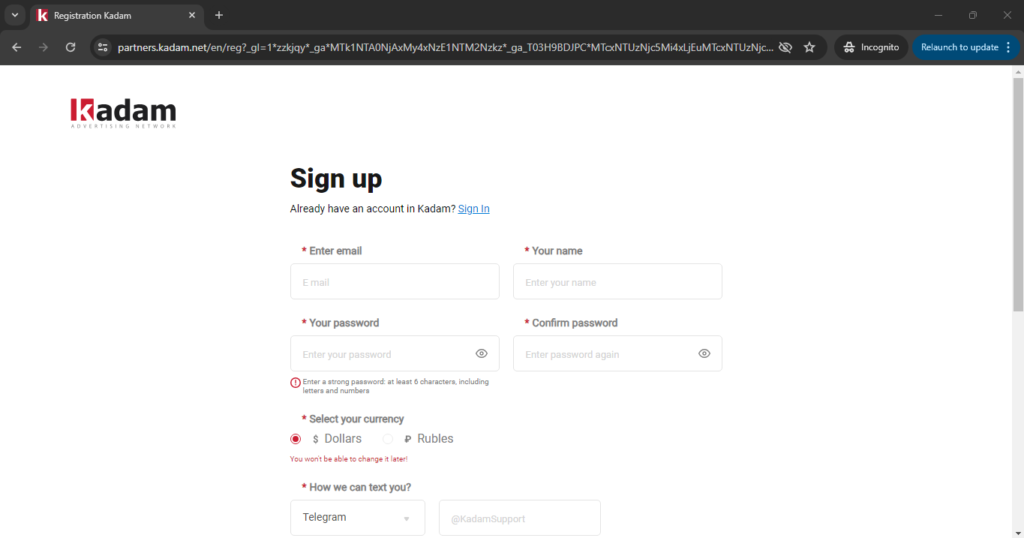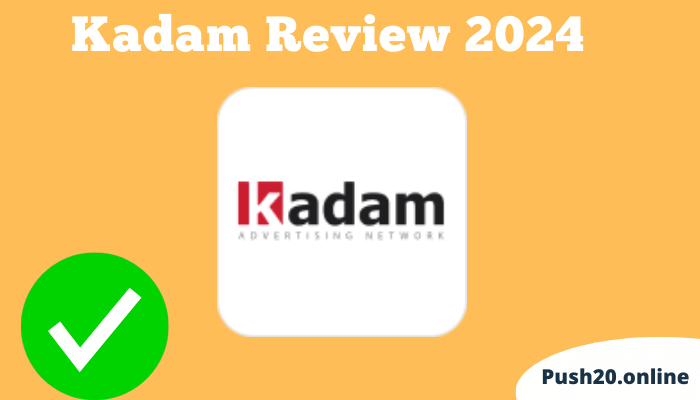Kadam Network is a push advertising network that stands out for its innovative features and robust performance. Advertisers can reach their target audience more effectively with push ads, which have revolutionized digital advertising. Push ads are simple, clickable messages on a user’s phone. They’re less intrusive than pop-ups and get more engagement than other advertising formats. But what exactly is Kadam Review 2024, and how does it work? Let’s learn more about this platform.
What is Kadam?
Kadam is a leading advertising platform that connects advertisers with the most relevant audience. It employs advanced targeting and optimization technologies to ensure every ad impression becomes an actionable engagement. The platform is designed to be user-friendly, even for those new to digital advertising. Kadam empowers users to fine-tune their marketing efforts at its core, maximizing conversions and profits. Affiliates looking to diversify their ad strategies will find its focus on user experience and technical versatility compelling.
How to SetUp Account with Kadam
Step 1: Visit the Official Kadam Website
Start by navigating to the official Kadam website. Ensure you’re visiting the correct site to avoid any security issues. The homepage provides an overview of their services, but you’re here to create an account, so look for the “Sign Up” button.

Step 2: Sign Up
Click on “Sign Up” to fill out a form. You’ll need your name, email, and password. A valid email is crucial since Kadam will send a verification link to this address. Agree to the terms and conditions, then proceed to verify your email.
Step 3: Email Verification
Check your inbox for an important email from Kadam. If you can’t find it, check your spam folder. Once located, click the verification link to secure your account and unlock the full range of Kadam’s features. Don’t miss out on this essential step to protect your information and enjoy everything Kadam offers.
Step 4: Login and Explore the Dashboard
After verifying your account, log in using your credentials. You’ll be directed to the dashboard, the control center for your campaigns. Get familiar with the layout and tools. The dashboard is designed to be intuitive, but understanding its functionality is key to maximizing your campaigns’ performance.
Step 5: Setting Up Your First Campaign
You are now ready to set up your first campaign once you have familiarized yourself with the dashboard. To start a campaign, click “Create Campaign”. Here are the steps you need to take:
- Define your campaign goal: Traffic, leads, or sales should all have a clear objective.
- Choose your target audience: You can target your ads based on location, device type, and more with Kadam.
- Create your ad: Design your push notification, keeping it concise and engaging.
Step 6: Funding Your Account
Before launchi your campaign, you’ll need to add funds to your account. Kadam typically offers various payment methods, including credit cards, PayPal, and others. You will be guided to complete the transaction by following the prompts.
Step 7: Monitoring and Optimizing
After launching your campaign, closely track its progress using the Kadam dashboard. Gain valuable insights into crucial metrics like click-through and conversion rates. Leverage this data to refine your campaign strategies and maximize your return on investment.
Creating a Campaign on Kadam
Step 1: Setting Up Your Account
The first step in your journey is to set up an account on Kadam. This process is straightforward:
- Click “Sign Up” on the Kadam website.
- Fill in the required information, including your email address, company details, and contact information.
- Verify your account through the email sent by Kadam.
- Log in to your new Kadam account to get started.
Step 2: Defining Your Campaign Objectives
Before launching your Kadam campaign, establish specific, measurable objectives. What are your desired outcomes? Are you looking to elevate brand visibility, attract more website visitors, or increase sales? A clearly defined goal is essential for shaping your campaign strategy and evaluating its overall effectiveness.
Step 3: Creating Your Campaign
With your objectives in place, you’re ready to create your campaign. Follow these steps to launch your campaign on Kadam:
- Navigate to the Campaign Section: Once logged in, go to the campaign section of your dashboard.
- Choose Your Ad Format: Select the ad format that best suits your campaign goals. Kadam offers a variety of formats, including video ads, banner ads, and more.
- Set Your Target Audience: Select who should see your ads using Kadam’s targeting options. Target based on location, interests, device type, etc.
- Define Your Budget and Schedule: Determine how much you want to spend and the duration of your campaign. Kadam provides flexible budgeting options to accommodate your financial plan.
- Design Your Ad: Create compelling ad content that aligns with your objectives. Make sure your ads are engaging and convey your message.
- Launch Your Campaign: After reviewing all details and ensuring everything is in order, launch your campaign.
Step 4: Monitoring and Optimizing Your Campaign
Kadam’s success depends on continuous monitoring and optimization. Keep track of your campaign’s performance and adjust as needed. Your audience will respond best to a variety of ad formats, targeting options, and creatives.
Ad Formats at Kadam
Kadam offers different ad formats to meet different advertising needs. We will explore each type in more detail below.
1. Push Notifications:
Push Notifications stand out as a cornerstone of Kadam Push Adsnetwork’s offerings. They’re delivered directly to users’ devices, even when they’re not browsing or using apps. What sets Push Notifications apart is their ability to re-engage users with personalized messages, offers, and reminders, boosting user retention and conversion rates. Advertisers can ensure their message is seen and heard by directly communicating with their audiences.
2. In-Page Push:
Integrated seamlessly into website content, in-page push ads let you reach new audiences. Your advertising reach will be expanded without disrupting the user experience with these eye-catching ads that look like native push notifications. In-page push ads offer targeted messaging, don’t require opt-ins, and are a powerful tool to drive user engagement and conversions.
3. Pop-Under Ads:
Pop-Under Ads are designed to open behind the active browser window, coming into view only when the user closes the main browsing window. This subtle approach ensures maximum visibility for your message without disrupting the user’s browsing experience. Pop-Under Ads are ideal for promoting products, services, or offers that require more detailed explanation, providing advertisers with a captive audience once the user encounters the ad.
4. Native Ads:
They appear seamlessly in any media format and fit the look, feel, and function of the medium. Native Ads are less likely to lead to banner blindness, which is a problem with traditional advertising. These ads are versatile and able to adapt to various content types and platforms, ensuring that your message resonates with the target audience in a non-intrusive manner.
5. Banner Ads:
Banner ads remain a staple in digital advertising, and they are known for their visual appeal and strategic placement on web pages. Kadam Push Adsnetwork revitalizes this classic format with advanced targeting options and creative designs that capture attention and encourage clicks. Banner Ads can be placed at any point on a webpage, offering significant visibility and making them an effective promotional tool.
5. Interstitial Ads:
Interstitial ads, strategically placed between natural breaks in user flow (like game levels or before premium content), command attention with full-screen displays. These immersive ads optimize screen real estate for impactful messaging, driving strong brand recall and high click-through rates, especially valuable in mobile gaming and app environments.
Pros and Cons of Using Kadam
Like any tool, Kadam has its advantages and potential drawbacks. As an affiliate marketer, it’s crucial to weigh these factors against your business needs and objectives.
Pros:
- Advanced Targeting Options: Kadam’s robust targeting capabilities allow for highly personalized campaigns that can significantly improve conversion rates.
- User-Friendly Interface: The platform’s well-designed dashboard and helpful on-screen guides simplify campaign setup and management.
- Optimization Tools: Kadam’s optimization algorithms use real-time data to refine your campaigns, ensuring they remain effective.
Cons:
- Traffic Volume: Kadam’s traffic volume may be more limited than that of some larger platforms, especially in niche markets.
- Learning Curve for Newbies: While the interface is user-friendly, understanding the nuances of Kadam’s features and optimization may require a learning curve for inexperienced marketers.
- Support Resources: Some users have reported lacking support resources, with limited documentation and learning materials.
Pricing Plans for Kadam
Kadam offers a few distinct pricing plans tailored to the needs of different affiliate marketers. The plans range from basic packages ideal for beginners to comprehensive solutions for seasoned professionals. Here’s a glimpse at what they offer:
Starter Plan:
- Ideal for newcomers
- Limited features, including targeting options and tracking
- Suitable for those testing the waters
Pro Plan:
- Designed for intermediate marketers
- Expanded targeting options and more robust tracking capabilities
- Access to Kadam’s optimization tools
Premium Plan:
- An all-encompassing package of severe marketers
- Advanced targeting and retargeting
- High-level analytics and insights
- Priority support
Pricing Models for Kadam
Kadam operates on two main pricing models – Cost-Per-Click (CPC) and Cost-Per-View (CPV). By using these models, you only pay when a user interacts with your advertisement.
The CPC Model
A Cost-Per-Click campaign can drive traffic to a website. When a user clicks on your advertisement, you are charged. Ad quality and keyword competition can affect your cost-per-click.
The CPV Model
Video ads use the Cost-Per-View model. Your video ad is charged every time a user views it. A video’s length and targeting options can influence its cost per view.
Why Opt for Kadam’s Pricing Models?
Kadam’s flexible pricing models are suitable for businesses of all sizes. You can customize Kadam’s pricing models according to your specific requirements, whether you’re a startup or an established corporation.
- Transparency and Flexibility
Kadam offers complete control over your advertising spend. You can set daily limits and adjust them as required. You can also track your campaigns’ performance in real-time using Kadam’s transparent reporting tools.
- High-Quality Traffic
Kadam strictly abides by a policy against fraudulent traffic. This ensures that you’re paying for authentic clicks and views from real users, optimizing your conversion rates and ensuring optimal usage of your ad spend.
- User-Friendly Interface
You can create and manage your ad campaigns easily with Kadam’s intuitive interface. Also, their dedicated customer support team is always on standby to help with any issues.
Conclusion
Affiliate marketing is made more accessible with Kadam’s powerful features and tools. Its ad formats, targeting capabilities, and user experience put it at the forefront of digital marketing. Kadam integration depends on factors like your niche, promotions, and familiarity with the affiliate platform.
Implementing Kadam effectively could enhance visibility, engagement, and conversion rates. Keeping up with platforms like Kadam is essential to your affiliate marketing success.
